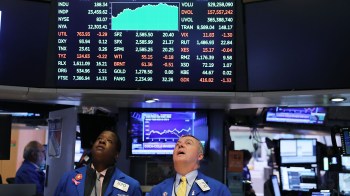
Home prices have risen 423% in 40 years, fueling economic discontent
Home prices have risen 423% in 40 years, fueling economic discontent

We’ve been dealing with high inflation in this economy over the last several years, with everything from groceries to new vehicles to construction supplies soaring in price.
But for one item in particular — houses — we’ve seen such sharp inflation over decades that it’s starting to change the landscape of American economic life. What happens in society, and in history, when costs for basic necessities, like shelter and food, shoot up in price?
Let’s start by going back four decades, to 1984. The movie “Ghostbusters” was a blockbuster that year. And the median price of a new home wasn’t so scary: $79,900 in the fourth quarter of 1984, according to data from the Department of Housing and Urban Development.
Since then, consumer prices overall have risen 203%, according to the Bureau of Labor Statistics information and analysis section. Meanwhile, the median price of a new home was $417,700 in the fourth quarter of 2023. That works out to an inflation rate of 423%.
“There’s no question that the cost of a house has gone up relative to cost of living overall,” said Christopher Mayer, co-director of the Paul Milstein Center for Real Estate at Columbia Business School. “More and more, a single-family home has become a luxury good, which has not been the case in the United States until now. It’s a trend that, if it continues, I think will change society substantially.”
Mayer conducted research in the 2010s finding that approximately 80% of people 65 and older owned their own homes, including a significant proportion who had neither a high school nor a college degree.
He said that for previous generations, working-class homeownership was plausible, even likely. “Homeownership was not just about people in the middle or the upper middle class, homeownership was something that people in the lower middle class could have.”
He’s seen this play out in his own family: “My in-laws lived in Reading, Pennsylvania; neither graduated from college. And yet, they were homeowners and owned multiple houses over their lives — having a part of the American dream. That would be very difficult for folks in the same circumstance, looking at the cost of homes today.”
This is not the first time America has dealt with rapid, destabilizing price increases, said Thomas Stapleford, an economic historian at the University of Notre Dame. “The big moments of price inflation are happening around wars — Civil War, World War I, World War II.”
In the early 1940s, as the U.S. prepared for war, factory towns sprang up across the country devoted to war production.
“So you have this big influx of workers coming into an area where there’s not adequate housing at the time, there’s not necessarily adequate services,” said Stapleford. “So food prices, shelter prices are going way up.”
The federal government took a number of actions in response, Stapleford said. It imposed price and wage controls, while the Bureau of Labor Statistics beefed up data gathering and analysis to better track inflation. Consumer product companies, meanwhile, got creative: “You have producers trying to navigate price controls and doing things like, ‘Well, maybe we’ll reduce the size of what’s going in a package, lower the quality of an item, use cheaper fabric.’ American housewives know that in fact prices are going up way more than the BLS index is showing.”
Under wartime rules, unions had to petition the government for pay increases, which they supported with a public relations campaign calling attention to rising prices. The government countered by trying to convince consumers inflation wasn’t all that bad.
“At one point in 1944, they actually produced a radio script called ‘Housewife versus Economist,’” Stapleford said. “It featured the acting director of the Bureau of Labor Statistics having a conversation with his wife. He talks about things like, ‘Well, you went and you purchased apples, and you saw the apples are so much more expensive than they were before. But maybe you didn’t notice how sugar prices are still the same.’”
The government was trying to calm American housewives, in part because of how badly they had reacted to soaring food prices in the World War I period, Stapleford explained. “It’s food that’s the dominant feature at that point. For a working-class family, food took up a huge part of the budget.”
Half or more of an urban working family’s monthly budget, in fact. In 1917, when food prices doubled, working-class women in New York rioted, just like they had more than a decade before in what came to be known as the 1902 kosher meat boycott.
This is a long tradition, going back to the 1500s, according to Robert DuPlessis, emeritus professor of economic history at Swarthmore College.
“In Europe in the 16th century, there was long-term inflation — partly due to population increase, part of it the influx of silver and gold from the New World,” DuPlessis explained. “Grain is the basic foodstuff. You can eat it as bread, you can eat it as gruel, but you also drink it in beverages, particularly beer. And if there’s a harvest failure, people feel it immediately.”
When grain harvests in Western Europe repeatedly failed, “you actually get religious and political rebellion as a result of a disastrous bout of inflation. Grain prices basically triple in a couple of months.” People stopped buying meat and new clothes, DuPlessis said, so they could try and buy enough bread to survive. “You also see that people riot.”
DuPlessis sees parallels today, as high home prices ripple through the late-pandemic economy. People have to rent rather than buy; they cut back on essentials to pay for housing; and they don’t buy as many of the consumer goods that go into houses, like furniture and appliances.
“The housing inflation of today is a little bit like the grain inflation of the 16th — actually, into the 18th century,” DuPlessis said. “Because remember, grain riots had a lot to do with the onset of the French Revolution.”
However, there are some reasons why riot and revolution may not be in the cards today. For one thing, food prices haven’t doubled or tripled in a matter of months. Instead, it’s taken four years since the pandemic hit for food prices to go up 25%, according to BLS data.
And while new home prices have more than quintupled, that’s happened over 40 years. Meanwhile, as much as mortgage rates have gone up lately, they were twice as high in 1984, peaking that year above 14%.
Still, Chris Mayer at Columbia Business School said home price inflation is fueling a lot of current discontent and disillusionment.
“You have people who are really discouraged about the potential of becoming a homeowner,” Mayer said. “Consumers are not happy about their housing situation, and they don’t have a lot of confidence that’s going to change.”
Mayer said that for the past century, homeownership has been a key stepping stone for building wealth and achieving the American dream. “Housing is aspirational: ‘When I make a lot of money, when I have kids, when I get married, when I get to the next stage of my life — am I going to be able to do something that’s a little bit better?’ And losing some of that future is discouraging.”
Mayer posed the rhetorical question: “Are you better off relative to previous times? Housing leads the list of things where the answer to that question today for many people is: ‘No, I’m not better off.’”
Correction (April 16, 2024): A previous version of this story misspelled the name of Reading, the city in Pennsylvania.
There’s a lot happening in the world. Through it all, Marketplace is here for you.
You rely on Marketplace to break down the world’s events and tell you how it affects you in a fact-based, approachable way. We rely on your financial support to keep making that possible.
Your donation today powers the independent journalism that you rely on. For just $5/month, you can help sustain Marketplace so we can keep reporting on the things that matter to you.

















